Analysis of Bullying and Academic Performance in Secondary Schools
VerifiedAdded on 2022/01/13
|7
|2580
|148
Essay
AI Summary
This essay examines the detrimental effects of bullying on the academic performance of secondary school students (ages 12-16) in England, as highlighted by concerns from the Department for Education (DfE). It explores the link between bullying, including cyberbullying, and declining academic standards, referencing studies that confirm this negative impact on all students, regardless of their role in bullying. The paper proposes homeschooling as a potential solution, arguing that it removes students from toxic environments and offers greater control over their social interactions. The essay acknowledges challenges such as cyberbullying and socialization, while also highlighting the benefits of increased freedom and potentially improved academic outcomes. Finally, the essay suggests evaluating the effectiveness of homeschooling through surveys and grade comparisons to assess its impact on both the school climate and student performance.
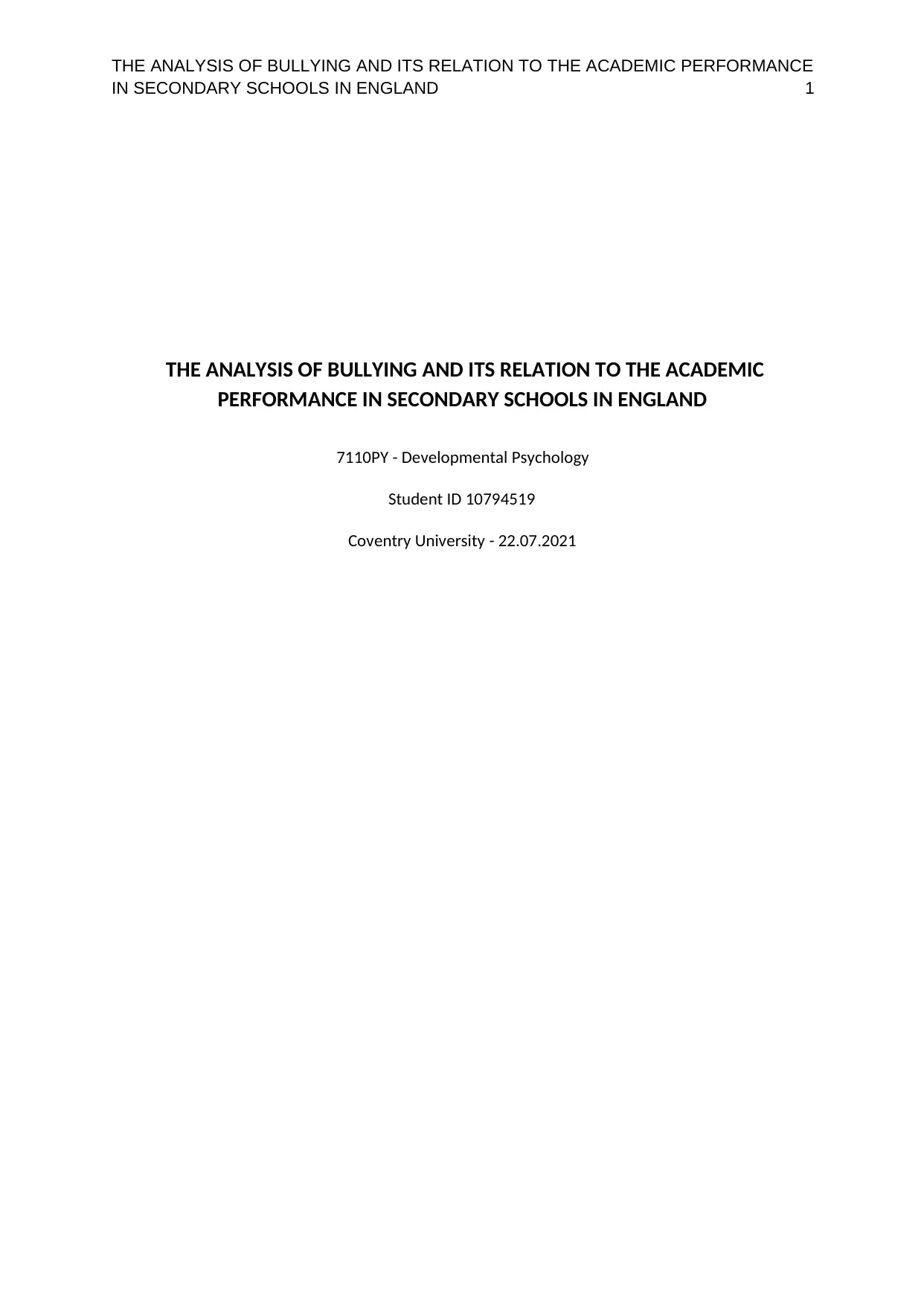
THE ANALYSIS OF BULLYING AND ITS RELATION TO THE ACADEMIC PERFORMANCE
IN SECONDARY SCHOOLS IN ENGLAND 1
THE ANALYSIS OF BULLYING AND ITS RELATION TO THE ACADEMIC
PERFORMANCE IN SECONDARY SCHOOLS IN ENGLAND
7110PY - Developmental Psychology
Student ID 10794519
Coventry University - 22.07.2021
IN SECONDARY SCHOOLS IN ENGLAND 1
THE ANALYSIS OF BULLYING AND ITS RELATION TO THE ACADEMIC
PERFORMANCE IN SECONDARY SCHOOLS IN ENGLAND
7110PY - Developmental Psychology
Student ID 10794519
Coventry University - 22.07.2021
Paraphrase This Document
Need a fresh take? Get an instant paraphrase of this document with our AI Paraphraser
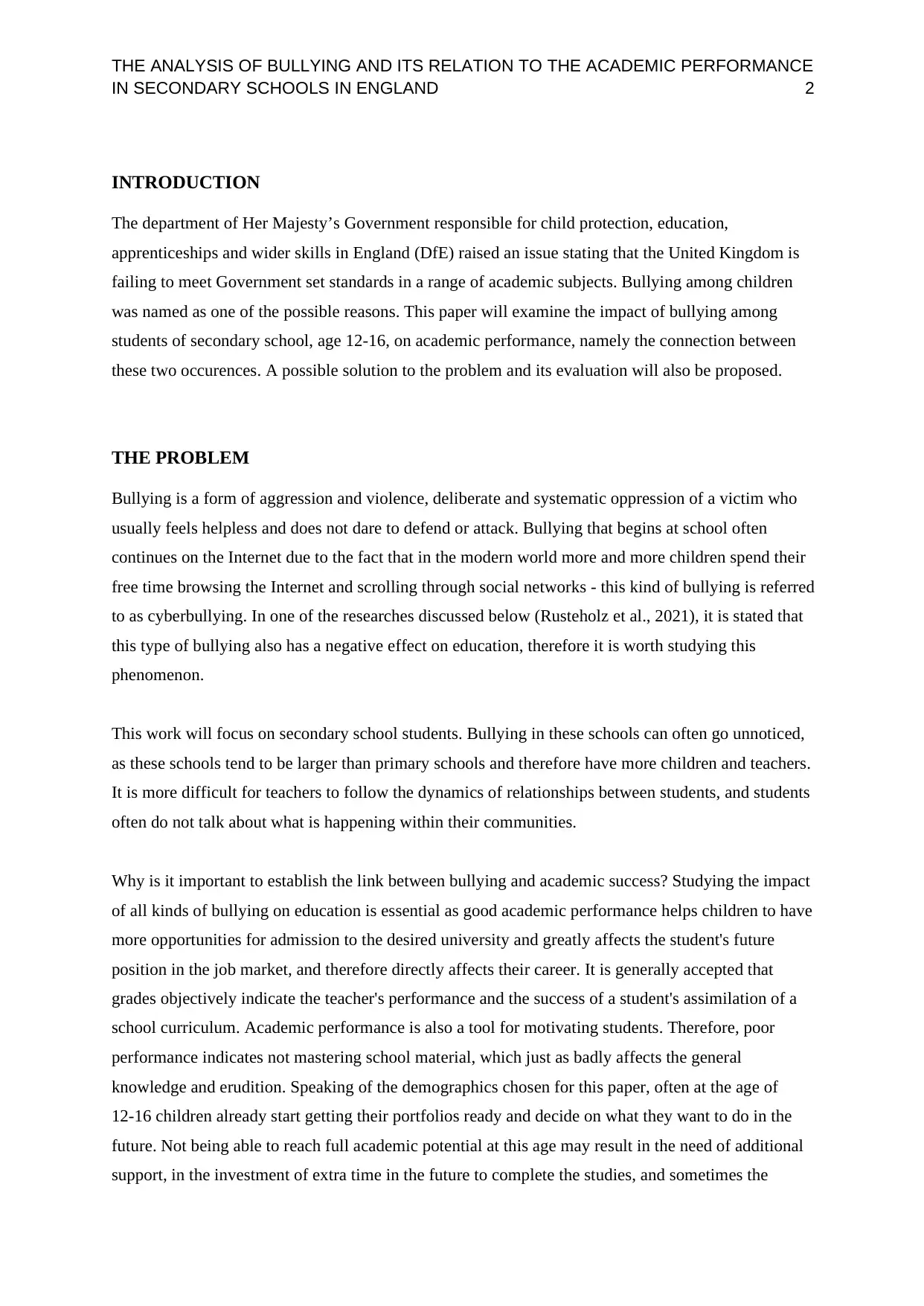
THE ANALYSIS OF BULLYING AND ITS RELATION TO THE ACADEMIC PERFORMANCE
IN SECONDARY SCHOOLS IN ENGLAND 2
INTRODUCTION
The department of Her Majesty’s Government responsible for child protection, education,
apprenticeships and wider skills in England (DfE) raised an issue stating that the United Kingdom is
failing to meet Government set standards in a range of academic subjects. Bullying among children
was named as one of the possible reasons. This paper will examine the impact of bullying among
students of secondary school, age 12-16, on academic performance, namely the connection between
these two occurences. A possible solution to the problem and its evaluation will also be proposed.
THE PROBLEM
Bullying is a form of aggression and violence, deliberate and systematic oppression of a victim who
usually feels helpless and does not dare to defend or attack. Bullying that begins at school often
continues on the Internet due to the fact that in the modern world more and more children spend their
free time browsing the Internet and scrolling through social networks - this kind of bullying is referred
to as cyberbullying. In one of the researches discussed below (Rusteholz et al., 2021), it is stated that
this type of bullying also has a negative effect on education, therefore it is worth studying this
phenomenon.
This work will focus on secondary school students. Bullying in these schools can often go unnoticed,
as these schools tend to be larger than primary schools and therefore have more children and teachers.
It is more difficult for teachers to follow the dynamics of relationships between students, and students
often do not talk about what is happening within their communities.
Why is it important to establish the link between bullying and academic success? Studying the impact
of all kinds of bullying on education is essential as good academic performance helps children to have
more opportunities for admission to the desired university and greatly affects the student's future
position in the job market, and therefore directly affects their career. It is generally accepted that
grades objectively indicate the teacher's performance and the success of a student's assimilation of a
school curriculum. Academic performance is also a tool for motivating students. Therefore, poor
performance indicates not mastering school material, which just as badly affects the general
knowledge and erudition. Speaking of the demographics chosen for this paper, often at the age of
12-16 children already start getting their portfolios ready and decide on what they want to do in the
future. Not being able to reach full academic potential at this age may result in the need of additional
support, in the investment of extra time in the future to complete the studies, and sometimes the
IN SECONDARY SCHOOLS IN ENGLAND 2
INTRODUCTION
The department of Her Majesty’s Government responsible for child protection, education,
apprenticeships and wider skills in England (DfE) raised an issue stating that the United Kingdom is
failing to meet Government set standards in a range of academic subjects. Bullying among children
was named as one of the possible reasons. This paper will examine the impact of bullying among
students of secondary school, age 12-16, on academic performance, namely the connection between
these two occurences. A possible solution to the problem and its evaluation will also be proposed.
THE PROBLEM
Bullying is a form of aggression and violence, deliberate and systematic oppression of a victim who
usually feels helpless and does not dare to defend or attack. Bullying that begins at school often
continues on the Internet due to the fact that in the modern world more and more children spend their
free time browsing the Internet and scrolling through social networks - this kind of bullying is referred
to as cyberbullying. In one of the researches discussed below (Rusteholz et al., 2021), it is stated that
this type of bullying also has a negative effect on education, therefore it is worth studying this
phenomenon.
This work will focus on secondary school students. Bullying in these schools can often go unnoticed,
as these schools tend to be larger than primary schools and therefore have more children and teachers.
It is more difficult for teachers to follow the dynamics of relationships between students, and students
often do not talk about what is happening within their communities.
Why is it important to establish the link between bullying and academic success? Studying the impact
of all kinds of bullying on education is essential as good academic performance helps children to have
more opportunities for admission to the desired university and greatly affects the student's future
position in the job market, and therefore directly affects their career. It is generally accepted that
grades objectively indicate the teacher's performance and the success of a student's assimilation of a
school curriculum. Academic performance is also a tool for motivating students. Therefore, poor
performance indicates not mastering school material, which just as badly affects the general
knowledge and erudition. Speaking of the demographics chosen for this paper, often at the age of
12-16 children already start getting their portfolios ready and decide on what they want to do in the
future. Not being able to reach full academic potential at this age may result in the need of additional
support, in the investment of extra time in the future to complete the studies, and sometimes the
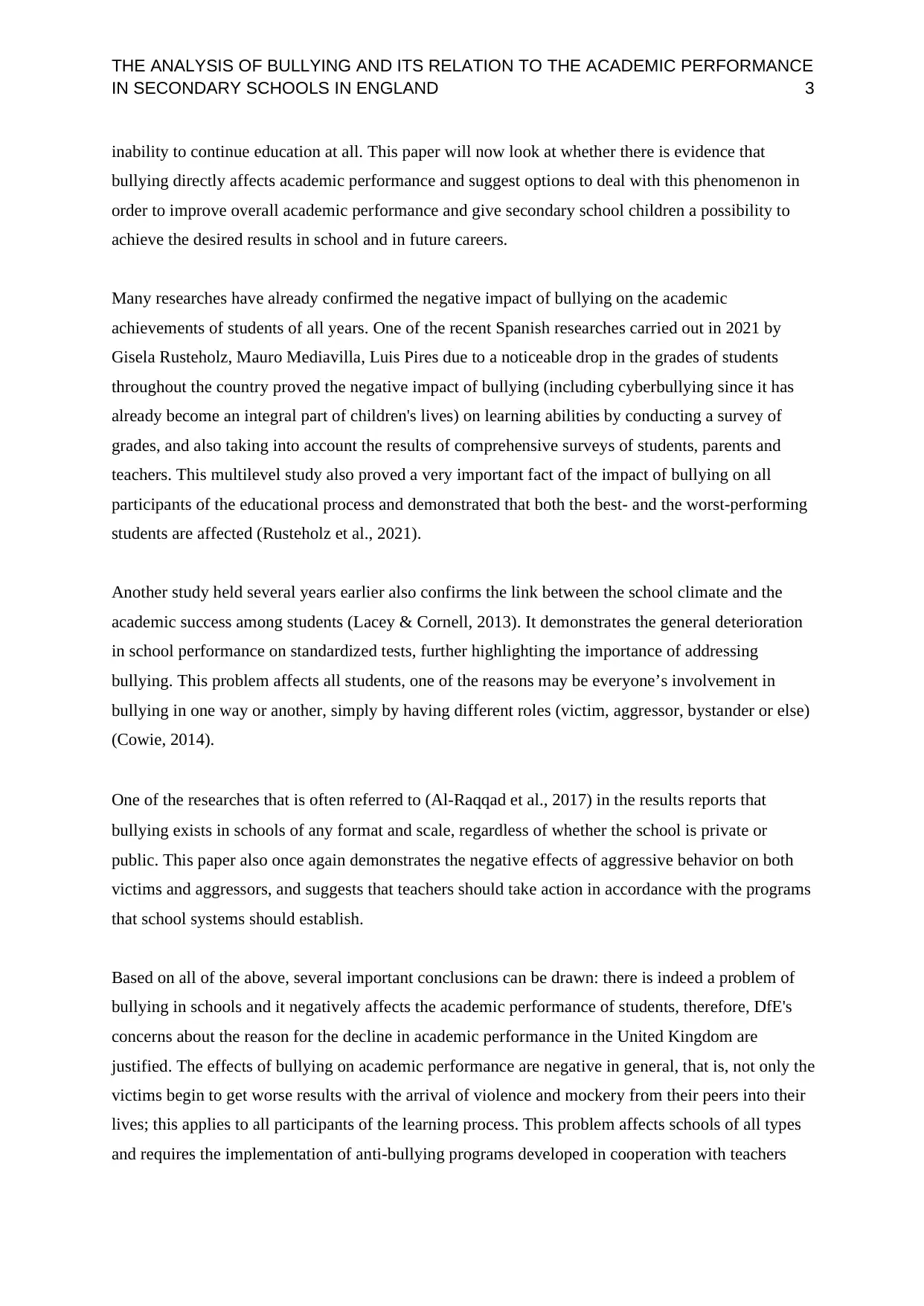
THE ANALYSIS OF BULLYING AND ITS RELATION TO THE ACADEMIC PERFORMANCE
IN SECONDARY SCHOOLS IN ENGLAND 3
inability to continue education at all. This paper will now look at whether there is evidence that
bullying directly affects academic performance and suggest options to deal with this phenomenon in
order to improve overall academic performance and give secondary school children a possibility to
achieve the desired results in school and in future careers.
Many researches have already confirmed the negative impact of bullying on the academic
achievements of students of all years. One of the recent Spanish researches carried out in 2021 by
Gisela Rusteholz, Mauro Mediavilla, Luis Pires due to a noticeable drop in the grades of students
throughout the country proved the negative impact of bullying (including cyberbullying since it has
already become an integral part of children's lives) on learning abilities by conducting a survey of
grades, and also taking into account the results of comprehensive surveys of students, parents and
teachers. This multilevel study also proved a very important fact of the impact of bullying on all
participants of the educational process and demonstrated that both the best- and the worst-performing
students are affected (Rusteholz et al., 2021).
Another study held several years earlier also confirms the link between the school climate and the
academic success among students (Lacey & Cornell, 2013). It demonstrates the general deterioration
in school performance on standardized tests, further highlighting the importance of addressing
bullying. This problem affects all students, one of the reasons may be everyone’s involvement in
bullying in one way or another, simply by having different roles (victim, aggressor, bystander or else)
(Cowie, 2014).
One of the researches that is often referred to (Al-Raqqad et al., 2017) in the results reports that
bullying exists in schools of any format and scale, regardless of whether the school is private or
public. This paper also once again demonstrates the negative effects of aggressive behavior on both
victims and aggressors, and suggests that teachers should take action in accordance with the programs
that school systems should establish.
Based on all of the above, several important conclusions can be drawn: there is indeed a problem of
bullying in schools and it negatively affects the academic performance of students, therefore, DfE's
concerns about the reason for the decline in academic performance in the United Kingdom are
justified. The effects of bullying on academic performance are negative in general, that is, not only the
victims begin to get worse results with the arrival of violence and mockery from their peers into their
lives; this applies to all participants of the learning process. This problem affects schools of all types
and requires the implementation of anti-bullying programs developed in cooperation with teachers
IN SECONDARY SCHOOLS IN ENGLAND 3
inability to continue education at all. This paper will now look at whether there is evidence that
bullying directly affects academic performance and suggest options to deal with this phenomenon in
order to improve overall academic performance and give secondary school children a possibility to
achieve the desired results in school and in future careers.
Many researches have already confirmed the negative impact of bullying on the academic
achievements of students of all years. One of the recent Spanish researches carried out in 2021 by
Gisela Rusteholz, Mauro Mediavilla, Luis Pires due to a noticeable drop in the grades of students
throughout the country proved the negative impact of bullying (including cyberbullying since it has
already become an integral part of children's lives) on learning abilities by conducting a survey of
grades, and also taking into account the results of comprehensive surveys of students, parents and
teachers. This multilevel study also proved a very important fact of the impact of bullying on all
participants of the educational process and demonstrated that both the best- and the worst-performing
students are affected (Rusteholz et al., 2021).
Another study held several years earlier also confirms the link between the school climate and the
academic success among students (Lacey & Cornell, 2013). It demonstrates the general deterioration
in school performance on standardized tests, further highlighting the importance of addressing
bullying. This problem affects all students, one of the reasons may be everyone’s involvement in
bullying in one way or another, simply by having different roles (victim, aggressor, bystander or else)
(Cowie, 2014).
One of the researches that is often referred to (Al-Raqqad et al., 2017) in the results reports that
bullying exists in schools of any format and scale, regardless of whether the school is private or
public. This paper also once again demonstrates the negative effects of aggressive behavior on both
victims and aggressors, and suggests that teachers should take action in accordance with the programs
that school systems should establish.
Based on all of the above, several important conclusions can be drawn: there is indeed a problem of
bullying in schools and it negatively affects the academic performance of students, therefore, DfE's
concerns about the reason for the decline in academic performance in the United Kingdom are
justified. The effects of bullying on academic performance are negative in general, that is, not only the
victims begin to get worse results with the arrival of violence and mockery from their peers into their
lives; this applies to all participants of the learning process. This problem affects schools of all types
and requires the implementation of anti-bullying programs developed in cooperation with teachers
⊘ This is a preview!⊘
Do you want full access?
Subscribe today to unlock all pages.

Trusted by 1+ million students worldwide
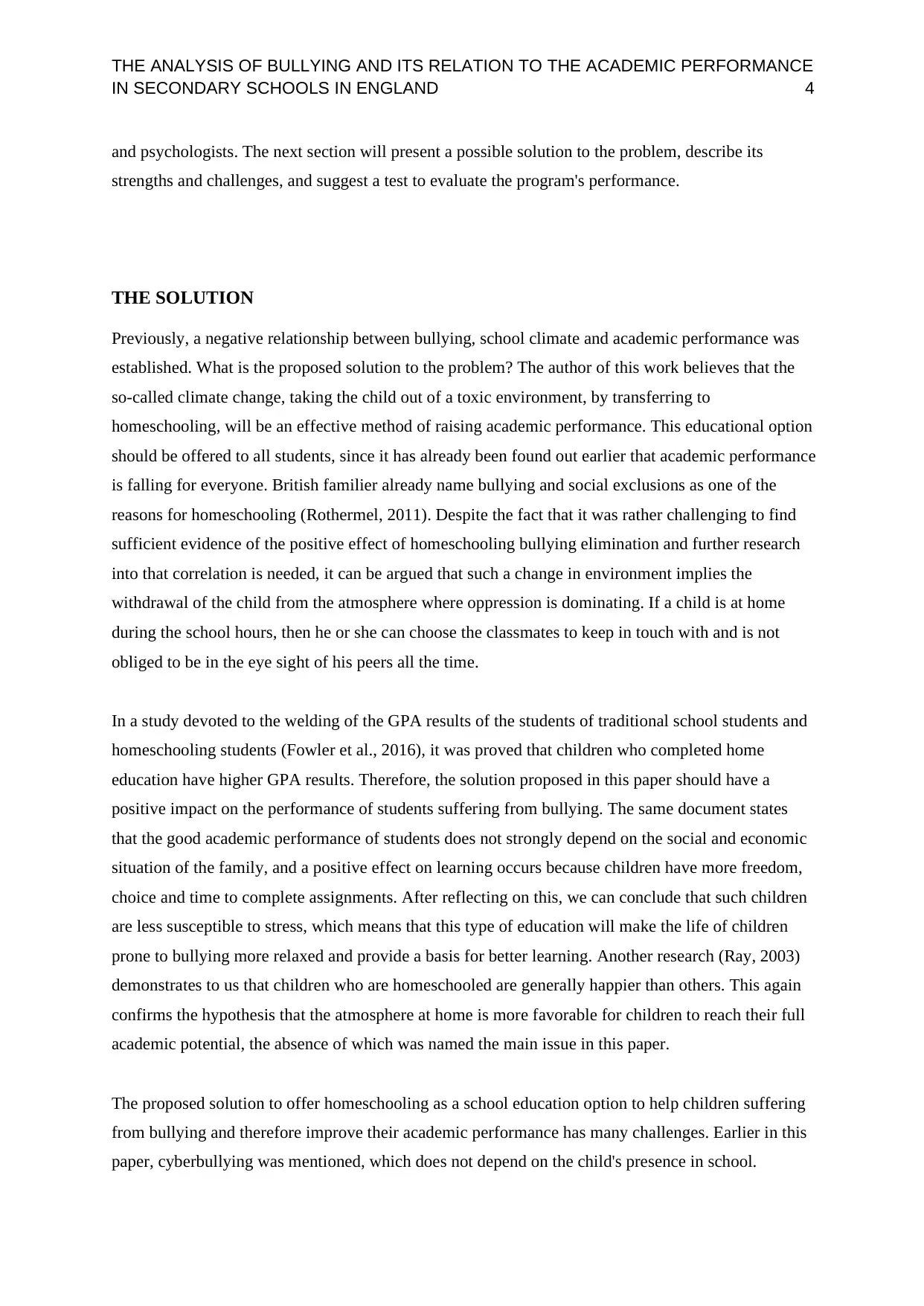
THE ANALYSIS OF BULLYING AND ITS RELATION TO THE ACADEMIC PERFORMANCE
IN SECONDARY SCHOOLS IN ENGLAND 4
and psychologists. The next section will present a possible solution to the problem, describe its
strengths and challenges, and suggest a test to evaluate the program's performance.
THE SOLUTION
Previously, a negative relationship between bullying, school climate and academic performance was
established. What is the proposed solution to the problem? The author of this work believes that the
so-called climate change, taking the child out of a toxic environment, by transferring to
homeschooling, will be an effective method of raising academic performance. This educational option
should be offered to all students, since it has already been found out earlier that academic performance
is falling for everyone. British familier already name bullying and social exclusions as one of the
reasons for homeschooling (Rothermel, 2011). Despite the fact that it was rather challenging to find
sufficient evidence of the positive effect of homeschooling bullying elimination and further research
into that correlation is needed, it can be argued that such a change in environment implies the
withdrawal of the child from the atmosphere where oppression is dominating. If a child is at home
during the school hours, then he or she can choose the classmates to keep in touch with and is not
obliged to be in the eye sight of his peers all the time.
In a study devoted to the welding of the GPA results of the students of traditional school students and
homeschooling students (Fowler et al., 2016), it was proved that children who completed home
education have higher GPA results. Therefore, the solution proposed in this paper should have a
positive impact on the performance of students suffering from bullying. The same document states
that the good academic performance of students does not strongly depend on the social and economic
situation of the family, and a positive effect on learning occurs because children have more freedom,
choice and time to complete assignments. After reflecting on this, we can conclude that such children
are less susceptible to stress, which means that this type of education will make the life of children
prone to bullying more relaxed and provide a basis for better learning. Another research (Ray, 2003)
demonstrates to us that children who are homeschooled are generally happier than others. This again
confirms the hypothesis that the atmosphere at home is more favorable for children to reach their full
academic potential, the absence of which was named the main issue in this paper.
The proposed solution to offer homeschooling as a school education option to help children suffering
from bullying and therefore improve their academic performance has many challenges. Earlier in this
paper, cyberbullying was mentioned, which does not depend on the child's presence in school.
IN SECONDARY SCHOOLS IN ENGLAND 4
and psychologists. The next section will present a possible solution to the problem, describe its
strengths and challenges, and suggest a test to evaluate the program's performance.
THE SOLUTION
Previously, a negative relationship between bullying, school climate and academic performance was
established. What is the proposed solution to the problem? The author of this work believes that the
so-called climate change, taking the child out of a toxic environment, by transferring to
homeschooling, will be an effective method of raising academic performance. This educational option
should be offered to all students, since it has already been found out earlier that academic performance
is falling for everyone. British familier already name bullying and social exclusions as one of the
reasons for homeschooling (Rothermel, 2011). Despite the fact that it was rather challenging to find
sufficient evidence of the positive effect of homeschooling bullying elimination and further research
into that correlation is needed, it can be argued that such a change in environment implies the
withdrawal of the child from the atmosphere where oppression is dominating. If a child is at home
during the school hours, then he or she can choose the classmates to keep in touch with and is not
obliged to be in the eye sight of his peers all the time.
In a study devoted to the welding of the GPA results of the students of traditional school students and
homeschooling students (Fowler et al., 2016), it was proved that children who completed home
education have higher GPA results. Therefore, the solution proposed in this paper should have a
positive impact on the performance of students suffering from bullying. The same document states
that the good academic performance of students does not strongly depend on the social and economic
situation of the family, and a positive effect on learning occurs because children have more freedom,
choice and time to complete assignments. After reflecting on this, we can conclude that such children
are less susceptible to stress, which means that this type of education will make the life of children
prone to bullying more relaxed and provide a basis for better learning. Another research (Ray, 2003)
demonstrates to us that children who are homeschooled are generally happier than others. This again
confirms the hypothesis that the atmosphere at home is more favorable for children to reach their full
academic potential, the absence of which was named the main issue in this paper.
The proposed solution to offer homeschooling as a school education option to help children suffering
from bullying and therefore improve their academic performance has many challenges. Earlier in this
paper, cyberbullying was mentioned, which does not depend on the child's presence in school.
Paraphrase This Document
Need a fresh take? Get an instant paraphrase of this document with our AI Paraphraser
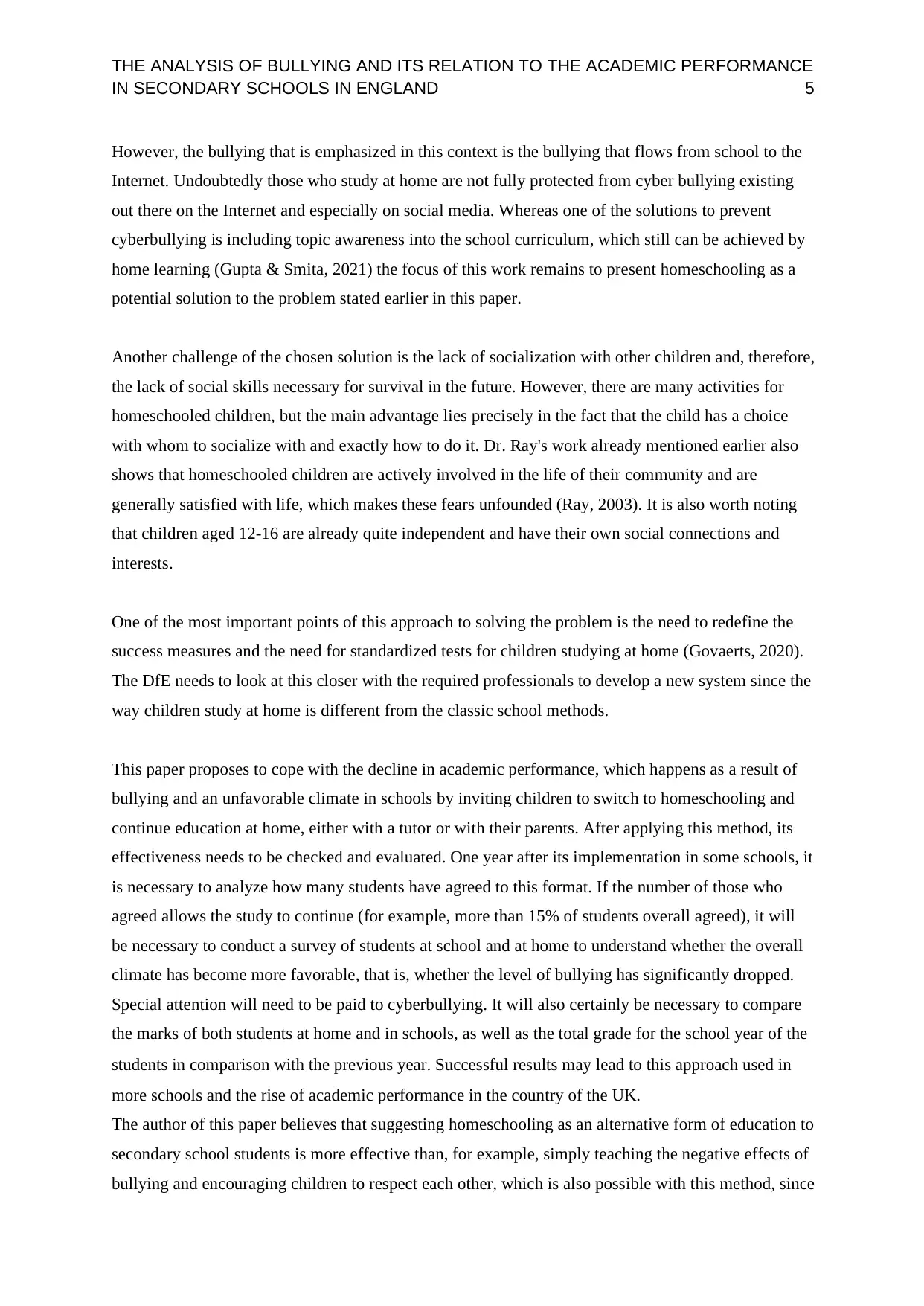
THE ANALYSIS OF BULLYING AND ITS RELATION TO THE ACADEMIC PERFORMANCE
IN SECONDARY SCHOOLS IN ENGLAND 5
However, the bullying that is emphasized in this context is the bullying that flows from school to the
Internet. Undoubtedly those who study at home are not fully protected from cyber bullying existing
out there on the Internet and especially on social media. Whereas one of the solutions to prevent
cyberbullying is including topic awareness into the school curriculum, which still can be achieved by
home learning (Gupta & Smita, 2021) the focus of this work remains to present homeschooling as a
potential solution to the problem stated earlier in this paper.
Another challenge of the chosen solution is the lack of socialization with other children and, therefore,
the lack of social skills necessary for survival in the future. However, there are many activities for
homeschooled children, but the main advantage lies precisely in the fact that the child has a choice
with whom to socialize with and exactly how to do it. Dr. Ray's work already mentioned earlier also
shows that homeschooled children are actively involved in the life of their community and are
generally satisfied with life, which makes these fears unfounded (Ray, 2003). It is also worth noting
that children aged 12-16 are already quite independent and have their own social connections and
interests.
One of the most important points of this approach to solving the problem is the need to redefine the
success measures and the need for standardized tests for children studying at home (Govaerts, 2020).
The DfE needs to look at this closer with the required professionals to develop a new system since the
way children study at home is different from the classic school methods.
This paper proposes to cope with the decline in academic performance, which happens as a result of
bullying and an unfavorable climate in schools by inviting children to switch to homeschooling and
continue education at home, either with a tutor or with their parents. After applying this method, its
effectiveness needs to be checked and evaluated. One year after its implementation in some schools, it
is necessary to analyze how many students have agreed to this format. If the number of those who
agreed allows the study to continue (for example, more than 15% of students overall agreed), it will
be necessary to conduct a survey of students at school and at home to understand whether the overall
climate has become more favorable, that is, whether the level of bullying has significantly dropped.
Special attention will need to be paid to cyberbullying. It will also certainly be necessary to compare
the marks of both students at home and in schools, as well as the total grade for the school year of the
students in comparison with the previous year. Successful results may lead to this approach used in
more schools and the rise of academic performance in the country of the UK.
The author of this paper believes that suggesting homeschooling as an alternative form of education to
secondary school students is more effective than, for example, simply teaching the negative effects of
bullying and encouraging children to respect each other, which is also possible with this method, since
IN SECONDARY SCHOOLS IN ENGLAND 5
However, the bullying that is emphasized in this context is the bullying that flows from school to the
Internet. Undoubtedly those who study at home are not fully protected from cyber bullying existing
out there on the Internet and especially on social media. Whereas one of the solutions to prevent
cyberbullying is including topic awareness into the school curriculum, which still can be achieved by
home learning (Gupta & Smita, 2021) the focus of this work remains to present homeschooling as a
potential solution to the problem stated earlier in this paper.
Another challenge of the chosen solution is the lack of socialization with other children and, therefore,
the lack of social skills necessary for survival in the future. However, there are many activities for
homeschooled children, but the main advantage lies precisely in the fact that the child has a choice
with whom to socialize with and exactly how to do it. Dr. Ray's work already mentioned earlier also
shows that homeschooled children are actively involved in the life of their community and are
generally satisfied with life, which makes these fears unfounded (Ray, 2003). It is also worth noting
that children aged 12-16 are already quite independent and have their own social connections and
interests.
One of the most important points of this approach to solving the problem is the need to redefine the
success measures and the need for standardized tests for children studying at home (Govaerts, 2020).
The DfE needs to look at this closer with the required professionals to develop a new system since the
way children study at home is different from the classic school methods.
This paper proposes to cope with the decline in academic performance, which happens as a result of
bullying and an unfavorable climate in schools by inviting children to switch to homeschooling and
continue education at home, either with a tutor or with their parents. After applying this method, its
effectiveness needs to be checked and evaluated. One year after its implementation in some schools, it
is necessary to analyze how many students have agreed to this format. If the number of those who
agreed allows the study to continue (for example, more than 15% of students overall agreed), it will
be necessary to conduct a survey of students at school and at home to understand whether the overall
climate has become more favorable, that is, whether the level of bullying has significantly dropped.
Special attention will need to be paid to cyberbullying. It will also certainly be necessary to compare
the marks of both students at home and in schools, as well as the total grade for the school year of the
students in comparison with the previous year. Successful results may lead to this approach used in
more schools and the rise of academic performance in the country of the UK.
The author of this paper believes that suggesting homeschooling as an alternative form of education to
secondary school students is more effective than, for example, simply teaching the negative effects of
bullying and encouraging children to respect each other, which is also possible with this method, since
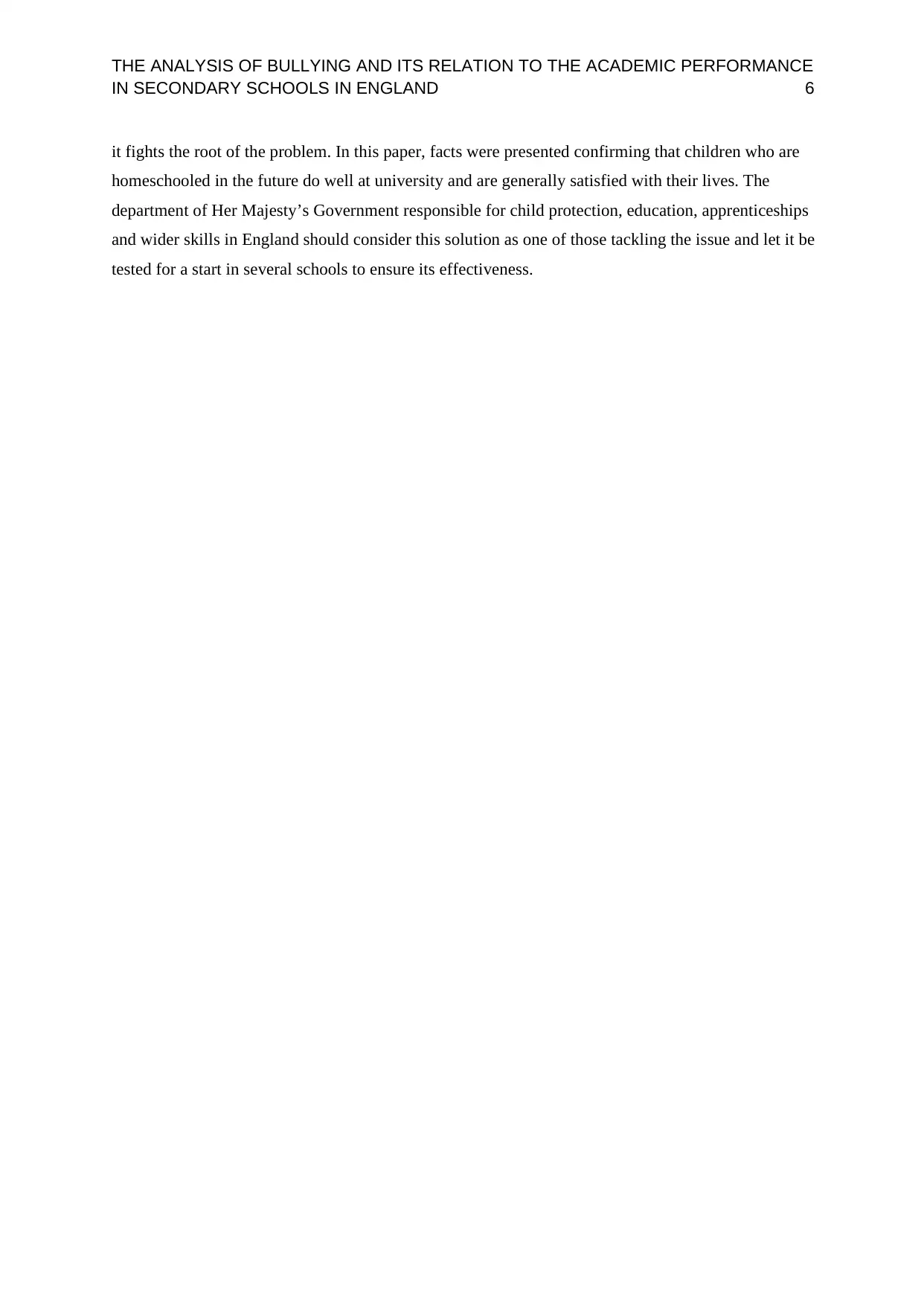
THE ANALYSIS OF BULLYING AND ITS RELATION TO THE ACADEMIC PERFORMANCE
IN SECONDARY SCHOOLS IN ENGLAND 6
it fights the root of the problem. In this paper, facts were presented confirming that children who are
homeschooled in the future do well at university and are generally satisfied with their lives. The
department of Her Majesty’s Government responsible for child protection, education, apprenticeships
and wider skills in England should consider this solution as one of those tackling the issue and let it be
tested for a start in several schools to ensure its effectiveness.
IN SECONDARY SCHOOLS IN ENGLAND 6
it fights the root of the problem. In this paper, facts were presented confirming that children who are
homeschooled in the future do well at university and are generally satisfied with their lives. The
department of Her Majesty’s Government responsible for child protection, education, apprenticeships
and wider skills in England should consider this solution as one of those tackling the issue and let it be
tested for a start in several schools to ensure its effectiveness.
⊘ This is a preview!⊘
Do you want full access?
Subscribe today to unlock all pages.

Trusted by 1+ million students worldwide
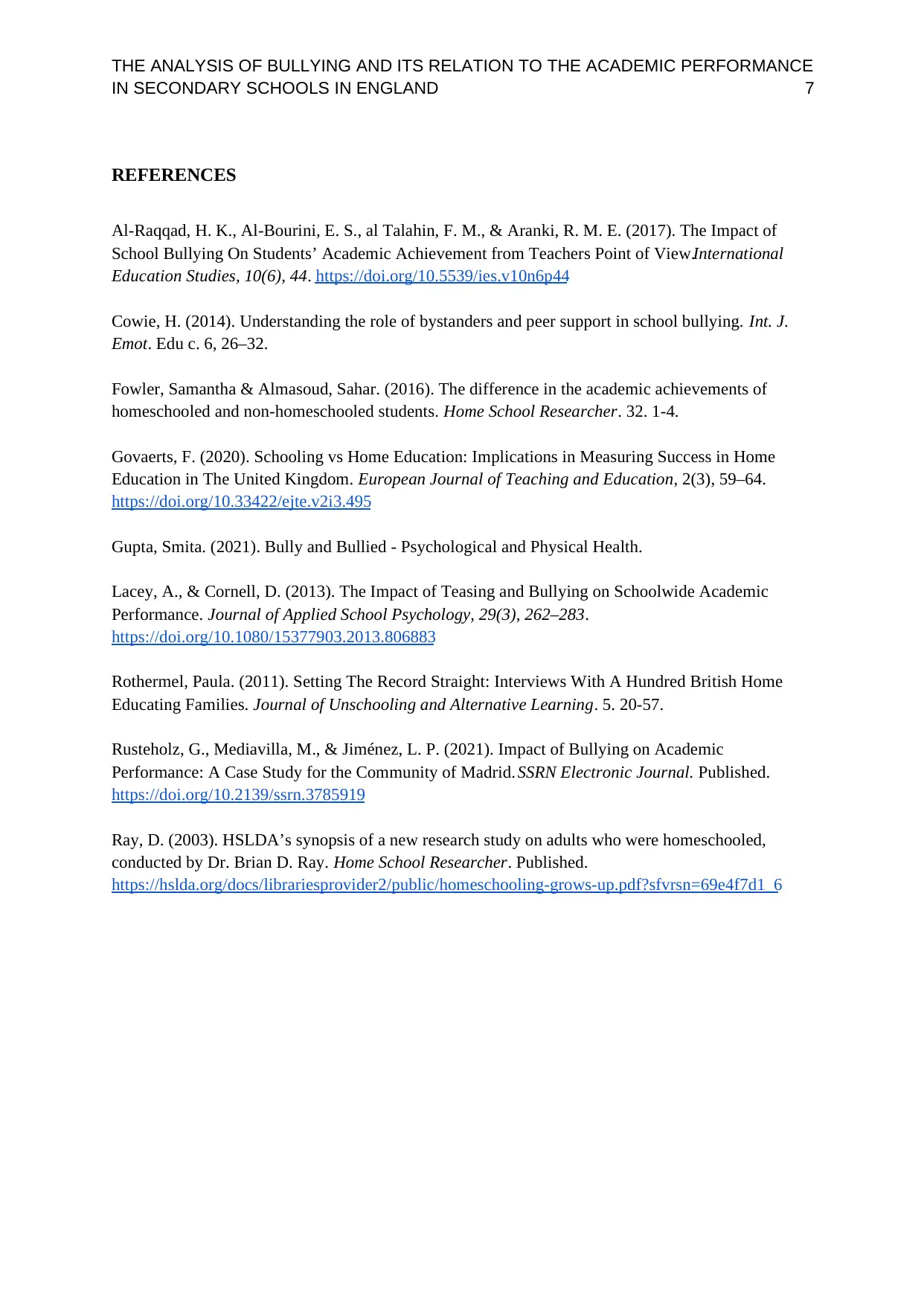
THE ANALYSIS OF BULLYING AND ITS RELATION TO THE ACADEMIC PERFORMANCE
IN SECONDARY SCHOOLS IN ENGLAND 7
REFERENCES
Al-Raqqad, H. K., Al-Bourini, E. S., al Talahin, F. M., & Aranki, R. M. E. (2017). The Impact of
School Bullying On Students’ Academic Achievement from Teachers Point of View.International
Education Studies, 10(6), 44. https://doi.org/10.5539/ies.v10n6p44
Cowie, H. (2014). Understanding the role of bystanders and peer support in school bullying. Int. J.
Emot. Edu c. 6, 26–32.
Fowler, Samantha & Almasoud, Sahar. (2016). The difference in the academic achievements of
homeschooled and non-homeschooled students. Home School Researcher. 32. 1-4.
Govaerts, F. (2020). Schooling vs Home Education: Implications in Measuring Success in Home
Education in The United Kingdom. European Journal of Teaching and Education, 2(3), 59–64.
https://doi.org/10.33422/ejte.v2i3.495
Gupta, Smita. (2021). Bully and Bullied - Psychological and Physical Health.
Lacey, A., & Cornell, D. (2013). The Impact of Teasing and Bullying on Schoolwide Academic
Performance. Journal of Applied School Psychology, 29(3), 262–283.
https://doi.org/10.1080/15377903.2013.806883
Rothermel, Paula. (2011). Setting The Record Straight: Interviews With A Hundred British Home
Educating Families. Journal of Unschooling and Alternative Learning. 5. 20-57.
Rusteholz, G., Mediavilla, M., & Jiménez, L. P. (2021). Impact of Bullying on Academic
Performance: A Case Study for the Community of Madrid. SSRN Electronic Journal. Published.
https://doi.org/10.2139/ssrn.3785919
Ray, D. (2003). HSLDA’s synopsis of a new research study on adults who were homeschooled,
conducted by Dr. Brian D. Ray. Home School Researcher. Published.
https://hslda.org/docs/librariesprovider2/public/homeschooling-grows-up.pdf?sfvrsn=69e4f7d1_6
IN SECONDARY SCHOOLS IN ENGLAND 7
REFERENCES
Al-Raqqad, H. K., Al-Bourini, E. S., al Talahin, F. M., & Aranki, R. M. E. (2017). The Impact of
School Bullying On Students’ Academic Achievement from Teachers Point of View.International
Education Studies, 10(6), 44. https://doi.org/10.5539/ies.v10n6p44
Cowie, H. (2014). Understanding the role of bystanders and peer support in school bullying. Int. J.
Emot. Edu c. 6, 26–32.
Fowler, Samantha & Almasoud, Sahar. (2016). The difference in the academic achievements of
homeschooled and non-homeschooled students. Home School Researcher. 32. 1-4.
Govaerts, F. (2020). Schooling vs Home Education: Implications in Measuring Success in Home
Education in The United Kingdom. European Journal of Teaching and Education, 2(3), 59–64.
https://doi.org/10.33422/ejte.v2i3.495
Gupta, Smita. (2021). Bully and Bullied - Psychological and Physical Health.
Lacey, A., & Cornell, D. (2013). The Impact of Teasing and Bullying on Schoolwide Academic
Performance. Journal of Applied School Psychology, 29(3), 262–283.
https://doi.org/10.1080/15377903.2013.806883
Rothermel, Paula. (2011). Setting The Record Straight: Interviews With A Hundred British Home
Educating Families. Journal of Unschooling and Alternative Learning. 5. 20-57.
Rusteholz, G., Mediavilla, M., & Jiménez, L. P. (2021). Impact of Bullying on Academic
Performance: A Case Study for the Community of Madrid. SSRN Electronic Journal. Published.
https://doi.org/10.2139/ssrn.3785919
Ray, D. (2003). HSLDA’s synopsis of a new research study on adults who were homeschooled,
conducted by Dr. Brian D. Ray. Home School Researcher. Published.
https://hslda.org/docs/librariesprovider2/public/homeschooling-grows-up.pdf?sfvrsn=69e4f7d1_6
1 out of 7
Related Documents
Your All-in-One AI-Powered Toolkit for Academic Success.
+13062052269
info@desklib.com
Available 24*7 on WhatsApp / Email
![[object Object]](/_next/static/media/star-bottom.7253800d.svg)
Unlock your academic potential
Copyright © 2020–2025 A2Z Services. All Rights Reserved. Developed and managed by ZUCOL.





